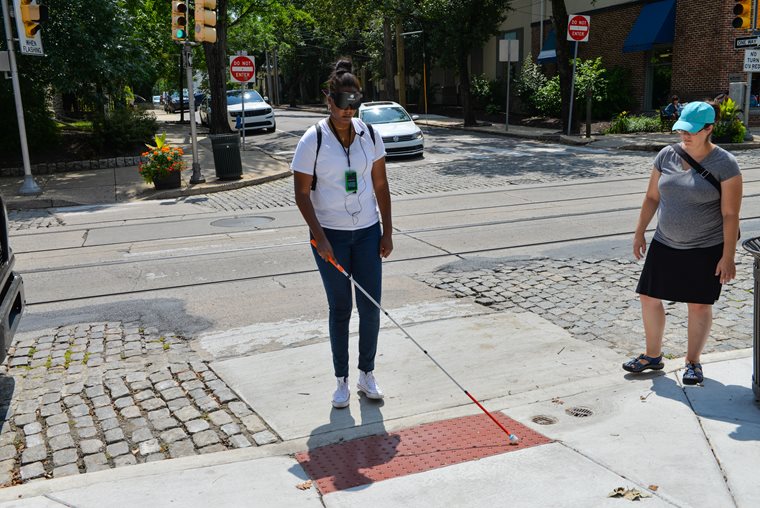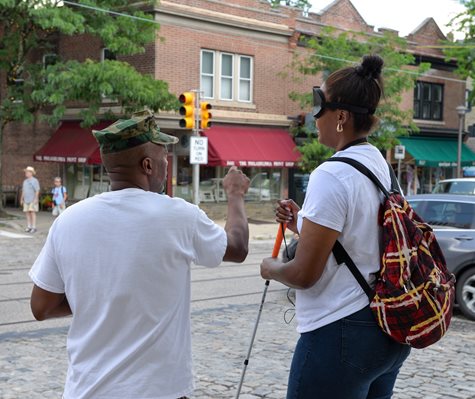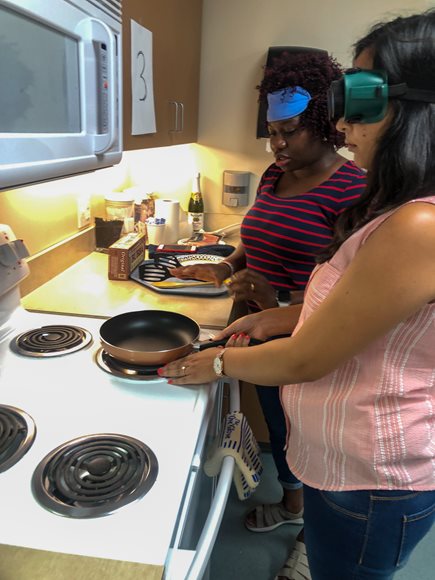Imagine trying to walk two blocks, complete with sidewalk sales tables, people sitting outside cafes talking on cellphones and enjoying coffee, and owners walking their dogs on leashes. Then add in the congestion of bumper-to-bumper traffic along cobblestone streets.
No big deal, right? OK, then try doing it blindfolded.
 That’s what students in the University’s Department of Blindness and Low Vision Studies (BLVS) Orientation and Mobility (O&M) program did in late July on the streets of Philadelphia’s Chestnut Hill neighborhood. Students experienced the challenges of trying to navigate a busy urban environment for those who are blind or have low vision.
That’s what students in the University’s Department of Blindness and Low Vision Studies (BLVS) Orientation and Mobility (O&M) program did in late July on the streets of Philadelphia’s Chestnut Hill neighborhood. Students experienced the challenges of trying to navigate a busy urban environment for those who are blind or have low vision.
Things that people with sight may take for granted as no big deal – the heights of the curbs, uneven or cracked sidewalks, trees, trash cans and flower boxes – cause extreme frustration for those with no sight.
“All these students are in courses for orientation mobility techniques, where they’re learning how to use a long white cane and navigate their environment,” said Amrah Baldini, orientation and mobility specialist and field instructor for the O&M program. “They go through the full experience. They’re blindfolded through all of their training on the techniques.”
The three students training that day – Nicole Jay ‘19BLVS, Shannon Spicer ‘20BLVS and Meghan Bretz ‘21BLVS – already trained on crossing the street. Their task during this session was learning how to solicit assistance when they’re not able to cross the street by themselves.
Asking for help to cross the street? It’s not as easy as it appears for vision impaired and blind people.
 “Most people are pretty helpful, but the help they give sometimes isn’t always helpful,” said Baldini.
“Most people are pretty helpful, but the help they give sometimes isn’t always helpful,” said Baldini.
Jay discovered that out immediately. The first student to put the blindfold on for the training session, Jay took an hour just to navigate two blocks of Chestnut Hill with her long white cane. Several times during the drill, she had to stop, pause and analyze the situation she was in. That’s what students are taught - don’t rush; there is nothing wrong with waiting. When you feel comfortable that you have the information you need, then go from there.
There were a handful of good Samaritans who offered to help, but that didn’t always go as planned.
“Soliciting assistance from people in the community isn’t always the best thing. Although they mean to be helpful, they can disorient you by taking you someplace that you might not be expecting to go, like the wrong side of the street,” said Jay. “I couldn’t see them, but I felt like everybody was pointing their directions and not one person was showing me the actual direction without pointing.”
Not surprisingly, that can be frustrating to a vision-impaired person.
 “Oh, I was frustrated, and I’m pretty sure it looked that way,” said Jay. “It does put into perspective what people have to go through to use the white cane and get around the community, how they’re perceived in the community.”
“Oh, I was frustrated, and I’m pretty sure it looked that way,” said Jay. “It does put into perspective what people have to go through to use the white cane and get around the community, how they’re perceived in the community.”
Students who complete the program will be orientation and mobility specialists and will then be teaching the blind and visually impaired how to navigate, whether that’s in their homes, their communities or with getting to a job or going to school.
“It’s a very open-minded, intense and tough summer,” said Baldini, who oversees the internship and fieldwork and who also graduated from the O&M program. “The students are thrown into this environment and it takes a lot of stamina to figure it all out. But when the students finish, they can work with the blind and visually impaired and help them through situations because they’ve been through those situations themselves.”
Learn More About Our Blindness and Low Vision Studies Programs